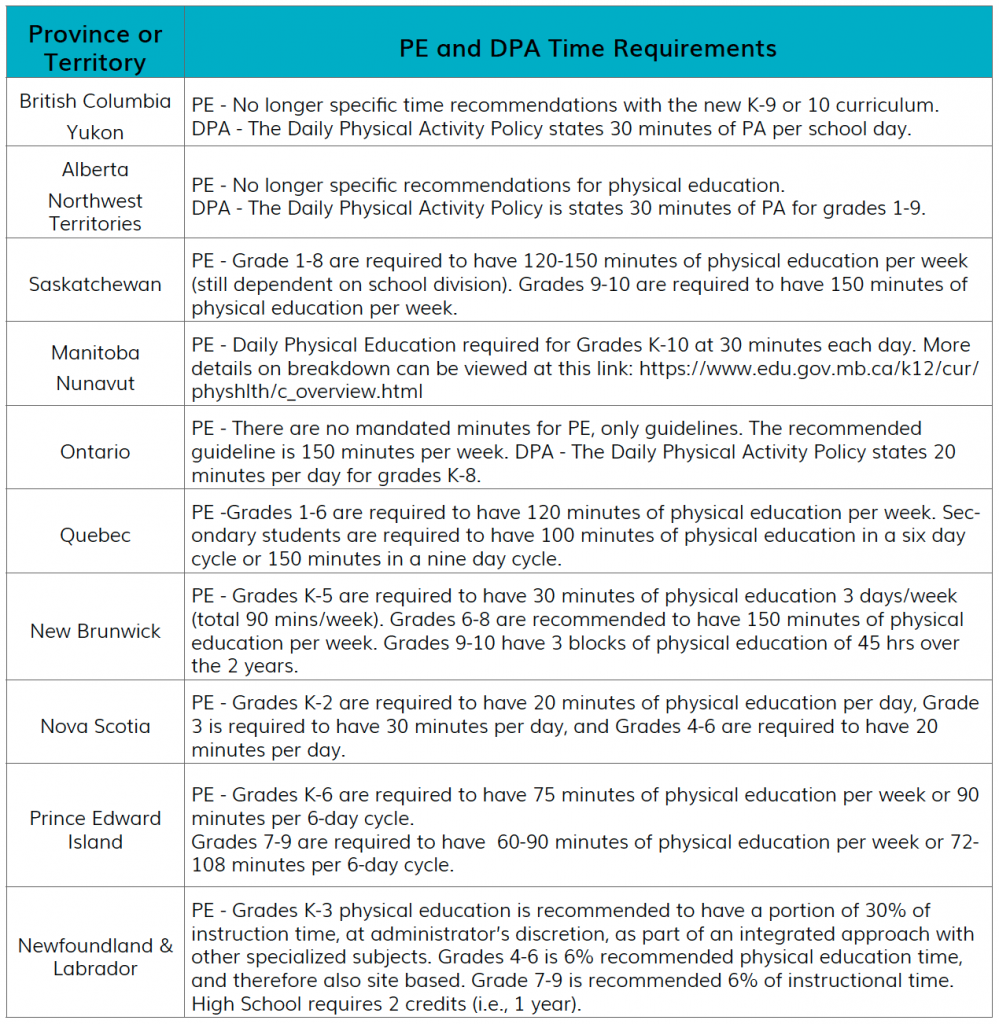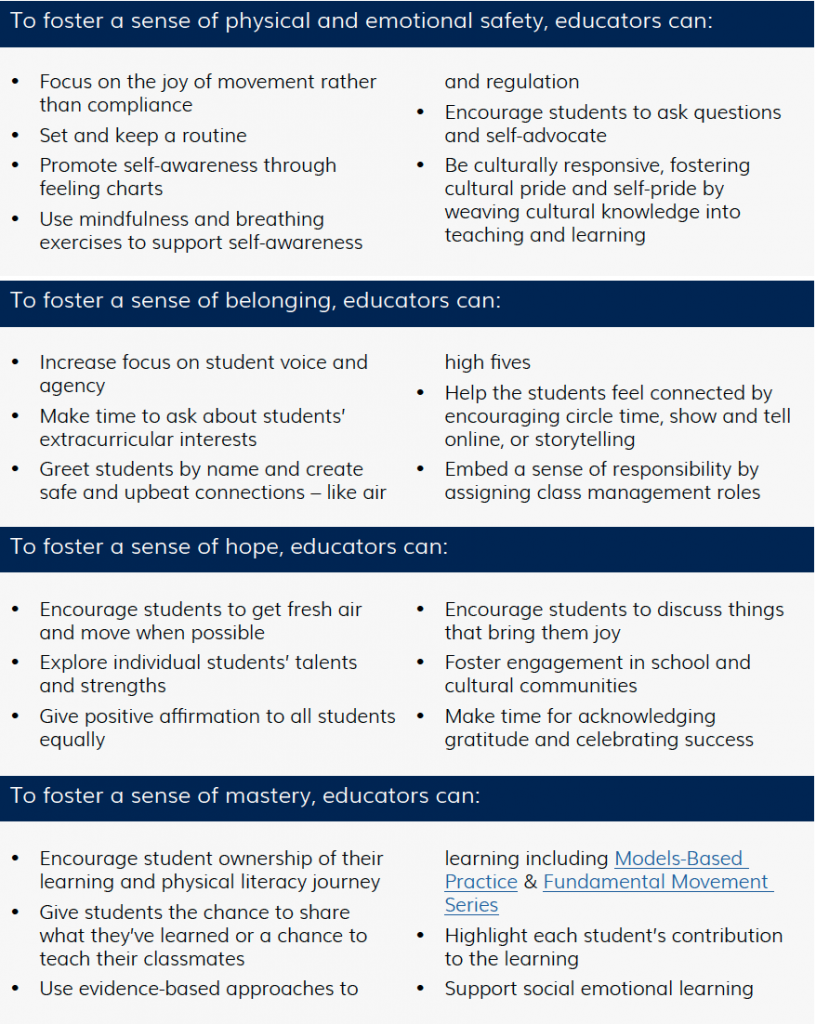With students returning to school, it is vitally important that all young people are welcomed into a safe and supportive learning environment and are equipped, through the PHE curriculum and health promoting opportunities, with the necessary skills to support their own health and well-being during these uncertain and difficult times.
The COVID-19 pandemic has placed unprecedented stress and difficulty on all Canadians. As a result, young peoples’ sense of trust, belonging, and hope have been deeply affected. Moreover, many of our students may have experienced physical and psychological trauma directly due to illness, food insecurity, social isolation, discrimination, anxiety and depression, and loss.

The following guidelines help to ensure our focus is on wholistic learning and development for all students:
Focus on Equity, Inclusion, and Accessibility: What considerations need to be in place to ensure PHE is accessible and inclusive for all?
The meaningful participation of all students, regardless of background, identity, or ability, is essential for optimal instruction and learning. Of equal importance, schools and educators will need to foster a culture of acceptance and belonging for all students. The current global health crisis has caused stress, trauma, and disruption in routine for many students, and these distressing feelings may have been compounded for students requiring additional learning support. The following considerations should be factored into this new learning environment to ensure the equity and inclusion of all students.
- Involve students in decision-making processes. Students are the experts of their own lives and should be encouraged to advocate for their own learning
- Continue to promote autonomy, challenge by choice, decision-making, and problem-solving for all students
- Recognize diversity. Students’ pandemic experiences may have looked and felt different than your own
- Get to know your students’ pandemic experiences including home environment, access to basic needs, and emotional well-being. Stress and trauma can inhibit learning, so consider a strength-based Trauma-Informed Teaching Approach for return to school learning
- Meet students where they are. Connect on a human level, formatively assess movement skills, and have students self-assess cognitive and emotional domains
- Be aware that students may move, think, feel, and act differently now and may need time to relearn skills
- Consider that technology is not available to everyone. Ensure that whatever learnings are to be done online are accessible for all students (e.g. captioning on videos, descriptive videos, readable PDFs)
- Utilize existing supports, such as the STEP Framework, for modifying programming as necessary to ensure students of all abilities can participate meaningfully
- Get creative about ways for students to connect emotionally and build skills like communication, cooperation, teamwork, and responsibility while still following physical distancing guidelines
Focus on Well-being: How do we support student learning and well-being across the school day?
- Where services are not available at school, strengthen relationships with community partners and service providers
- Deepen opportunities for outdoor learning, not just for PHE but for all subjects to increase movement
- Utilize physical activity across learning domains by accessing provincial/territorial PHE curriculum documents

- Use a flipped classroom model (see consideration below) to encourage a sense of control and shift the focus from direct instructional delivery of information to guiding students’ acquisition of knowledge and skills while exploring content together
- Explore Indigenous ways of knowing and doing, such as the Circle of Courage, a model of positive youth development first described in the book Reclaiming Youth at Risk, co-authored by Larry Brendtro, Martin Brokenleg, and Steve Van Bockern
- Establish a Healthy School Action Team to assess needs and assets and drive whole school health promotion programs. Following a process will ensure that work is done in a thoughtful and effective way. It will also lead to a higher level of success and be easier to track progress
- Embed a well-being orientation in lesson and activity planning to cultivate a sense of physical and emotional safety
- Take time to support Social Emotional Learning through games and activities
- Share necessary facts and information with students and their families/caregivers, but be sure to communicate at an appropriate level to minimize worry and stress
Focus on Trauma-Informed Approaches: How do we support health and well-being and recovery through the use of a trauma-informed approach?
Many students will have experienced trauma as a result of the COVID-19 pandemic. This trauma can impact learning, behaviour, and relationships at school. PHE Canada’s Teach Resiliency program highlights three core ideas:
- Trauma sensitive schools help students feel safe to learn
- Trauma sensitivity requires a whole-school effort
- Helping traumatized students learn should be a major focus of education
Here are 4 ways to work in a trauma-and-violence-informed way:
- Build trauma awareness and understanding of the high prevalence of trauma and violence, the impact of trauma on a student’s development, and the range of strategies that students and their families/caregivers use to cope
- Build safety and trust by creating a welcoming environment, pairing expectations with support, developing positive relationships with students and their families/caregivers, and thinking about safety
- Foster opportunities for choice, collaboration, and connection by listening, noticing, and responding with care and a shared vision for identifying services, supports, and care
- Use a strengths-based and capacity-building approach to support students

What is a Flipped Classroom?
A flipped classroom refers to a pedagogical approach in which the teacher assigns special interest items, such as videos, audio recordings, worksheets, quizzes, student activity handouts, and/or textbook readings, sequentially throughout the year. Students complete these tasks at home and arrive at school ready to put the knowledge they gained to practical use in a school environment.
As teachers of any subject, our goal is to engage students and promote active learning. The flipped classroom approach is one way in which we can shift the focus in our classes from direct instructional delivery of information to guiding students’ acquisition of knowledge and skills while exploring content together. This approach helps us to engage our students in deeper learning and helps them connect what they are learning at school to their personal lives.
Additionally, this approach can succeed in engaging parents/caregivers at home, showing them the potential benefits that PHE can bring to their lives as well. Finally, this approach is a great way to promote the many positive outcomes of your PHE program to families, colleagues, administrators, and society at large.
